The open road promises freedom, adventure, and, unfortunately, a degree of risk. Every time we turn the ignition, we expose ourselves to potential danger, largely due to the unpredictable nature of road traffic and the myriad factors that can lead to accidents. The threats are numerous, from the momentary lapse in concentration to adverse weather conditions, or mechanical failures to unpredicted actions of other road users. Our safety, and that of others, relies heavily on our understanding of these hazards and how we can best navigate or avoid them.
This comprehensive guide delves into the 15 most common types of road accidents, laying bare the causes, implications, and, most importantly, preventative measures associated with each. As we journey together through this crucial topic, we aim not to instill fear but to arm you with knowledge. The knowledge that can potentially save lives – your life and the lives of those you share the road with. So, buckle up and join us as we explore the road safety world, one accident type at a time.
Types Of Road Accidents
Road accidents can occur for many reasons, resulting in varying damage and injury. Here are fifteen of the most common types of road accidents:
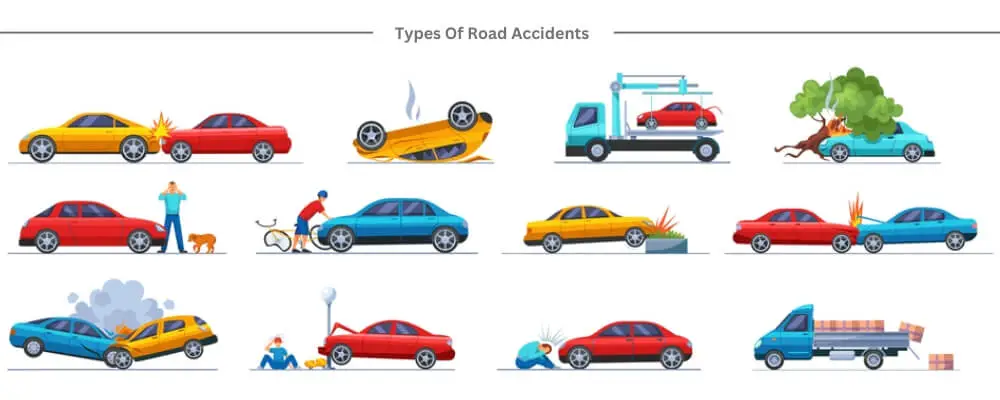
1. Rear-end Collisions
Rear-end collisions occur when a vehicle hits the one in front of it. These are commonly caused by distracted driving, where the driver is not paying adequate attention to the road, and tailgating, where there’s insufficient distance left between vehicles for safe stopping. Panic stops, where a vehicle suddenly brakes, can also lead to rear-end collisions, especially in reduced traction like wet or icy roads.
Although the driver in the rear is typically considered at fault in these scenarios, certain situations can complicate fault assignment, such as if the leading vehicle reverses suddenly or its brake lights are not functional.
2. Side-impact Collisions
Side-impact collisions, also known as “T-bone” collisions, transpire when the front or rear of a vehicle crashes into the side of another. They commonly occur at intersections, parking lots, or multi-lane roads due to failure to yield, disregarding traffic signals, or simple distraction. The peril of such incidents is heightened because the vehicle sides provide less structural protection than the front or rear, exposing occupants to more severe injuries. The design of modern cars has attempted to mitigate these risks with safety features like side airbags and reinforced doors, but the danger remains significant.
3. Head-on Collisions
Head-on collisions, characterized by the frontal impact between two vehicles, are among the most dangerous road accidents due to their potential for severe injury or fatality, especially at high speeds. Causes typically involve one driver mistakenly or recklessly entering a lane of oncoming traffic, which can result from factors like distraction, fatigue, impaired driving, or confusion in navigation. The suddenness and force of head-on collisions often leave little time for reaction, intensifying the impact and the potential for devastating outcomes. Safety measures like divided highways, clear road signage, and seatbelts, airbags in vehicles can mitigate but not eliminate the risks.
4. Single Vehicle Accidents
Single-vehicle accidents involve only one vehicle, which may collide with a fixed object, pedestrian, or animal or veer off the road. Causes can range from driver distractions like mobile devices, speeding, impairment due to substances, fatigue, or unfavorable weather conditions such as rain, snow, or fog. These accidents can lead to substantial damage to the vehicle and serious injuries, especially in vehicle rollovers or if the occupants are thrown from the vehicle.
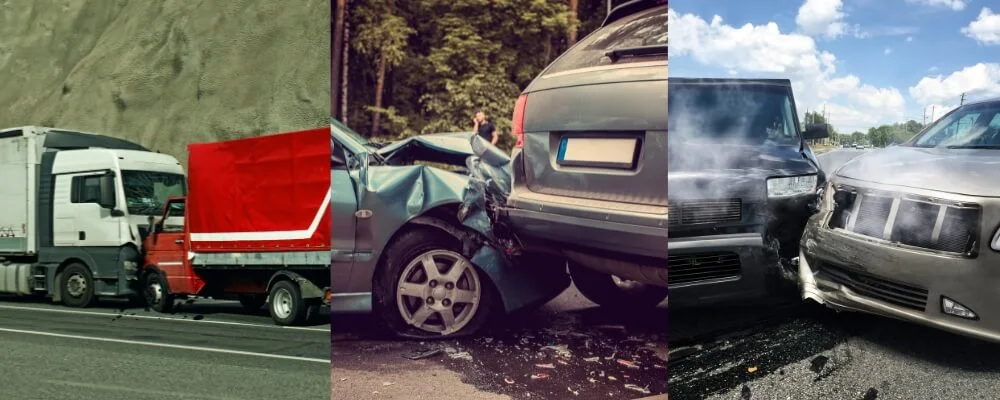
5. Multi-vehicle Pile-ups
Multi-vehicle pile-ups, often occurring on highways or freeways, involve three or more vehicles and are among the deadliest types of road accidents. The complex nature of these incidents, involving numerous vehicles often moving at high speeds, can lead to catastrophic damage and significant loss of life. They typically occur due to chain reactions triggered by an initial collision, with following vehicles unable to stop in time.
Adverse weather conditions such as fog, smoke, or ice are frequent contributors, as they can severely hamper visibility and road traction. Additionally, high-speed roads, traffic density, and driver behaviors like distraction or tailgating can exacerbate the risk and severity of these pile-ups.
6. Hit and Run Accidents
Hit-and-run accidents are incidents where a driver involved in a collision with another vehicle, pedestrian, or fixed object chooses to flee the scene without stopping to identify themselves, offer aid to injured parties, or fulfill their legal obligations. This illegal act can exacerbate the accident’s aftermath by leaving victims without immediate assistance.
The motivations for such actions often stem from fear of legal consequences, especially if the fleeing driver is uninsured, intoxicated, or engaging in illegal activities. These accidents add a layer of complexity to insurance claims and legal proceedings and can significantly hinder victims’ physical and emotional recovery.
7. Vehicle Rollover
Vehicle rollover accidents are incidents where a vehicle, particularly those with a high center of gravity, such as SUVs and large vans, tips over onto its side or roof. These accidents can be precipitated by a variety of factors. Sharp turns at high speeds can cause a vehicle to lose balance, while abrupt swerving maneuvers, often in response to an unexpected obstacle, can similarly result in a rollover.
‘Tripping,’ where a vehicle’s tire hits a curb, bump, or uneven surface, can cause the vehicle to flip. Rollovers are particularly dangerous due to the risk of occupants being ejected from the vehicle or crushed, making them one of the most fatal types of car accidents. Ensuring seatbelt use and careful driving, particularly in top-heavy vehicles, can help mitigate such risks.
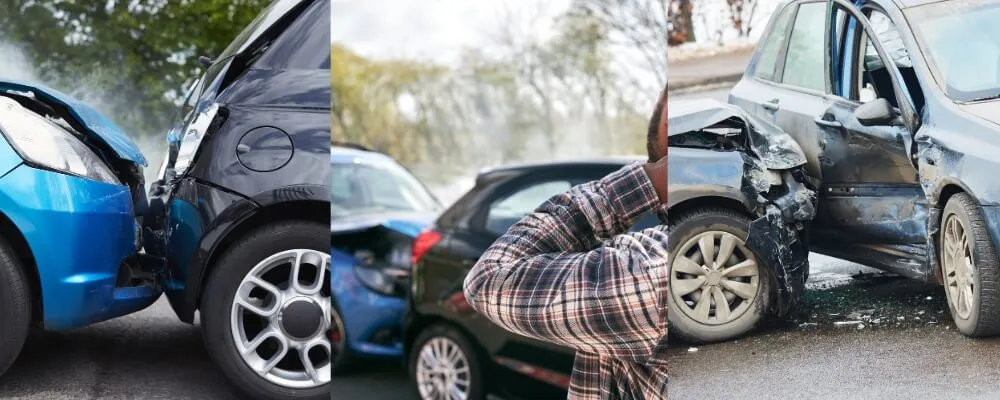
8. Intersection Accidents
Intersection or cross-traffic accidents occur when two or more vehicles moving across each other’s paths at intersections collide. These accidents can be particularly dangerous and are often a result of drivers failing to observe traffic signals, like running a red light or not yielding when required. Distracted driving, such as using a phone or other devices while driving, can also contribute to these incidents, as drivers may not notice changes in traffic lights or the movement of other vehicles.
Additionally, illegal maneuvers, such as making prohibited turns, or aggressive driving behaviors, like speeding through an intersection, increase the likelihood of intersection accidents. Therefore, attentiveness, patience, and strict adherence to traffic rules are essential when navigating intersections.
9. Pedestrian Accidents
Pedestrian accidents occur when a vehicle collides with someone walking on the road or roadside. These accidents can be severely detrimental to pedestrians due to a person’s vulnerability against a moving vehicle. High vehicle speeds can exacerbate the impact and severity of these incidents, giving both the driver and pedestrian less time to react. Both driver and pedestrian distractions, such as phone use or inattention to surroundings, are common contributing factors to these accidents.
Additionally, poor visibility conditions, such as night-time or adverse weather, can make pedestrians harder to spot. Pedestrian accidents highlight the need for diligent attention to road safety rules by drivers and pedestrians and the importance of appropriate infrastructure like crosswalks and pedestrian lights.
10. Motorcycle Accidents
Motorcycle accidents encompass a range of incidents involving a motorcycle involving a collision, whether with another vehicle, pedestrian, or object. The factors leading to these accidents can be unique due to the specific vulnerabilities of motorcyclists. Visibility issues are a leading cause, with other drivers often failing to spot motorcycles due to their smaller size or blind spots. Due to instability, road hazards such as potholes, debris, or wet leaves can pose more serious threats to motorcycles than to cars.
Furthermore, motorcyclists lack the protective shell a car provides its occupants, resulting in typically more severe injuries during accidents. Despite protective measures like helmets and protective clothing, motorcyclists are at high risk, emphasizing the need for increased awareness among all road users.
11. Bicycle Accidents
Bicycle accidents occur when a motor vehicle collides with a bicycle, often resulting in serious harm to cyclists due to their lack of protection compared to vehicle occupants. These accidents can be caused by various factors, including distractions for drivers and cyclists, such as using mobile devices, and failure to observe road rules, like not yielding to the right of way or running red lights. The act of ‘dooring,’ which happens when a vehicle occupant opens a car door in the path of an oncoming cyclist, is another significant cause.
Furthermore, a lack of safe cycling infrastructure like dedicated bike lanes or poorly designed intersections can increase the risk of these accidents. These incidents underscore the importance of attentive driving, cyclist visibility, and the need for adequate cycling infrastructure.
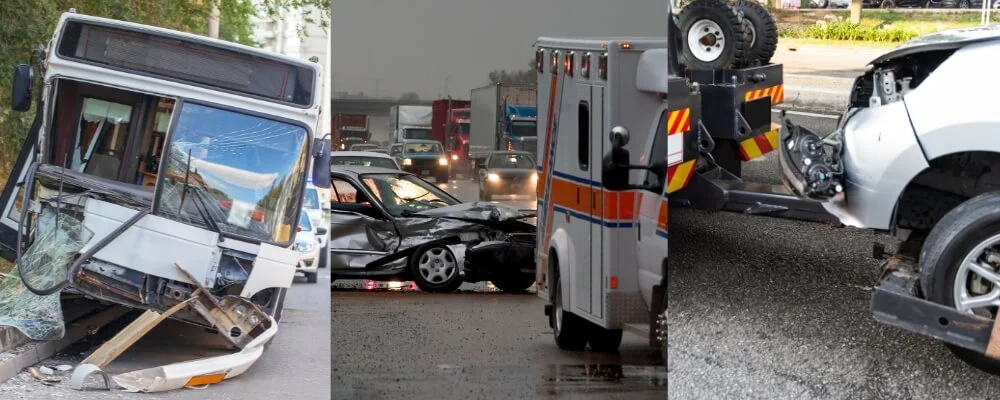
12. Large Truck Accidents
Large truck accidents involve commercial vehicles like semi-trucks and big rigs, which can result in serious consequences due to their size and weight. These accidents can be caused by driver fatigue, improper cargo loading, mechanical failures, or misunderstandings by other road users about truck maneuvering limits. These incidents underscore the need for proper truck maintenance, proper cargo loading, adherence to driver rest schedules, and increased public understanding of how trucks move and stop.
13. Bus Accidents
Bus accidents refer to incidents involving public or private buses and can result in numerous injuries or fatalities, given the vehicle size and the number of passengers onboard. Bus accidents can occur for various reasons, including driver error, speeding, distraction, or failure to adhere to traffic rules. Inadequate training of bus drivers may also lead to accidents, especially in challenging driving conditions or emergencies.
Vehicle rollovers, often resulting from sharp turns or collisions, are particularly dangerous given the number of unrestrained passengers. Collisions with other vehicles or stationary objects can also lead to serious bus accidents. The high-capacity nature of buses underscores the importance of stringent safety standards, including regular vehicle maintenance, comprehensive driver training, and effective safety regulations.
14. Off-road Accidents
Off-road accidents occur when a vehicle leaves the designated roadway, leading to possible rollovers or collisions with objects such as trees or rocks. These accidents can be caused by driver error, distractions, impairment, or poor environmental conditions. Due to the unpredictable nature of off-road environments, they can lead to serious injuries or fatalities. Practicing safe driving habits, using seat belts, and adjusting speed to match conditions can help reduce these risks.
15. Animal Collisions
Animal collisions occur when vehicles strike large animals like deer or kangaroos, causing significant vehicle damage and potential personal injury. These accidents are common during certain periods, such as the mating season, and in certain areas like forests or wildlife habitats. The likelihood of these incidents emphasizes the need for drivers to be vigilant, especially at dawn and dusk and in known animal crossing areas, and to use high-beam headlights for improved visibility.
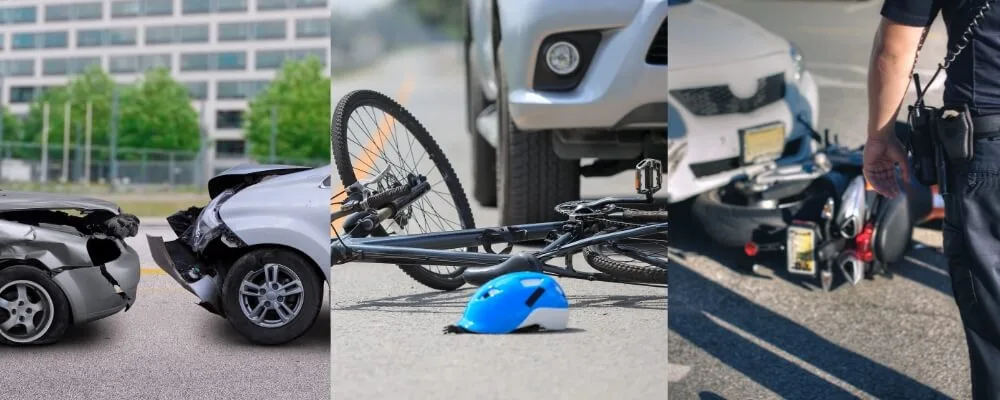
Different Causes Of These Road Accidents
While each type of road accident has specific contributing factors, there are several common underlying causes:
- Distracted Driving: This is one of the leading causes of road accidents. Activities such as texting, eating, or using a GPS can divert attention away from the road.
- Speeding: Driving above the speed limit can reduce the driver’s ability to steer safely around curves or objects in the roadway, extend the distance necessary to stop a vehicle, and increase the distance a vehicle travels. In contrast, the driver reacts to a dangerous situation.
- Drunk Driving: Consumption of alcohol or other intoxicants reduces the function of the brain, impairing thinking, reasoning, and muscle coordination, all of which are essential to operating a vehicle safely.
- Reckless Driving: This refers to a disregard for the rules of the road and can include changing lanes without signaling, tailgating, and other aggressive driving tactics.
- Weather Conditions: Rain, fog, sleet, or ice can make roads slippery and vision unclear, leading to accidents.
- Running Red Lights or Stop Signs: Drivers who run red lights or stop signs can cause severe accidents as they can hit a vehicle with the right of way.
- Night Driving: Reduced visibility and increased difficulty in judging distances in the dark can lead to accidents.
- Teenage Drivers: Teenagers lack experience and are often overconfident in their driving abilities, making them more likely to be involved in accidents.
- Design Defects: Sometimes accidents occur due to a defect in the vehicle, such as brake failure or tire blowouts.
- Wrong-Way Driving/ Improper Turns: Drivers who turn onto a street in the wrong direction or make prohibited turns can cause accidents.
- Animal Crossings: Especially in rural areas, wild animals can unexpectedly enter the road, leading to accidents.
- Driver Fatigue: Drowsiness can slow reaction time, decrease awareness, impair judgment, and increase the risk of crashing.
- Improper Loading: Overloading or not properly securing the load of commercial or personal-use pickup trucks can cause accidents.
These causes underscore the importance of safe driving habits, adherence to traffic laws, vehicle maintenance, and an understanding of current driving conditions.
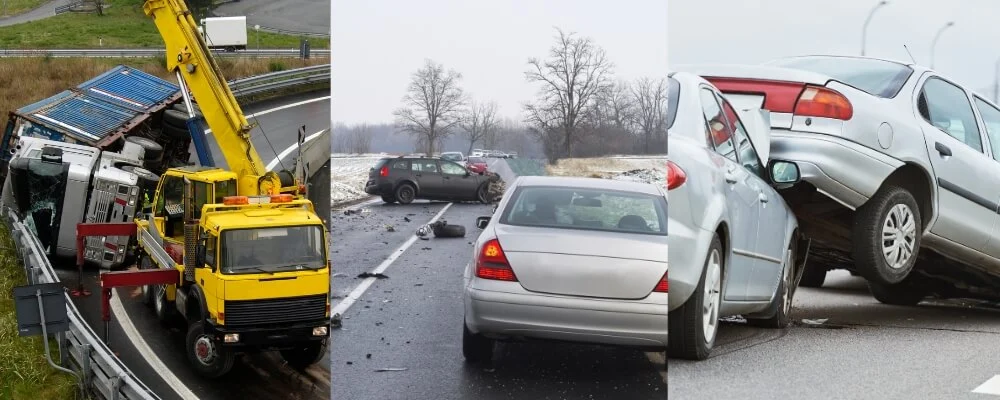
Basic Safety Rules To Prevent These Types Of Road Accidents
Road safety is paramount for all road users. Here are some basic safety rules that can help prevent accidents:
- Stay Focused: Distracted driving is a leading cause of accidents. Always keep your full attention on the road. Avoid using your phone or other activities that might distract you while driving.
- Don’t Speed: Respect the speed limits and adjust your speed according to road and traffic conditions. Remember, the faster you drive, the less time you have to react.
- Don’t Drive Under the Influence: Never drive after consuming alcohol, drugs, or other substances impairing your driving ability. If you’re going out and plan on drinking, arrange for a designated driver or use public transportation or a taxi.
- Use Seatbelts: Always wear your seatbelt and ensure all your passengers are buckled up. Seatbelts can dramatically increase your chances of survival in an accident.
- Follow Traffic Rules: Observe and obey all traffic signs, signals, and markings. Never run red lights or stop signs.
- Maintain Safe Distance: Keep a safe following distance between you and the vehicle ahead to give yourself enough time to react.
- Drive Defensively: Anticipate the actions of other road users and adjust your driving accordingly. Be especially cautious around pedestrians, cyclists, and motorcyclists.
- Keep Your Vehicle in Good Condition: Regular maintenance, including checking tire pressure, brake functionality, and lights, can prevent accidents caused by vehicle failure.
- Be Extra Careful in Adverse Conditions: Slow down and maintain a larger following distance in rain, fog, snow, or other challenging weather conditions.
- Rest If Tired: Fatigue significantly increases the risk of accidents. If you’re tired, stop in a safe place and rest or switch drivers.
- Use Indicators: Always use your vehicle’s indicators when turning or changing lanes to alert other road users of your intentions.
By following these rules, you can significantly reduce the risk of road accidents and contribute to safer roads for everyone.
Conclusion
Navigating our roads should not be a game of chance. Understanding the 15 most common types of road accidents we’ve discussed educates us on the dangers present. It sheds light on effective preventative measures that we can take to reduce the likelihood of these unfortunate incidents.
The common thread woven through each accident type is the importance of attentiveness, respect for traffic laws, and responsible driving habits. From the perils of rear-end collisions due to distracted driving to the tragic outcomes of head-on collisions caused by impairment, the implications of our actions behind the wheel are far-reaching and can have life-altering consequences.
Additionally, the roles of regular vehicle maintenance, understanding of driving conditions, and mindful consideration for other road users become starkly apparent when we examine single-vehicle crashes, large truck accidents, and those involving cyclists or pedestrians.
Ultimately, every journey we embark on is a shared responsibility. Our collective duty is to ensure that we, and our fellow road users, arrive at our destinations safely. This starts with knowledge, and through understanding these common types of road accidents, we can all contribute to making our roads safer. After all, a well-completed journey is one where everyone is safe.

